Durer
was still in his twenty when he established himself as the leading artist in
his native city of Nuremberg. His self-portrait, painted when he was 27,
clearly conveys his self-confidence and pride in his abilities. His skill as a
portraitist gained him numerous commissions from Nuremberg's leading citizens,
but his visual curiosity led him to lavish as much attention on humble subjects
such as A Hare as on more traditional and lucrative themes.
Durer's
two visits to Italy profoundly affected his art. In such ambitious works The Adoration
of the Magi and The Festival of the Rose Garlands he rivalled the great Italian
painters in richness of colouring, and in The Four Apostles he matched the
heroic arid monumental grandeur the High Renaissance.
It was
on his prints even more than on his paintings that Durer's international
reputation was based. Engravings such as The Knight, Death and the Devil and
Melencolia I were regarded with a seriousness that had previously been denied
this 'lowly' medium.
Durer
was obviously appearance and painted several self-portraits. In this one he is elegantly
dressed in th6eight of fashion. He sari himself as a cultured gentleman rather
than as a humble artisan, which had been the traditional status of artists.
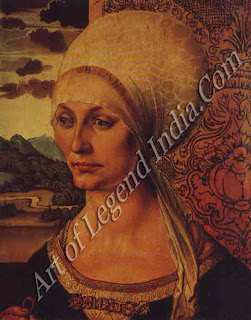 The
Tuchers were one of the leading families of Nuremberg. There was probably
originally companion portrait of Elsbeth's husband, showing him facing her, as
Durer painted another married couple from the family in this format.
The
Tuchers were one of the leading families of Nuremberg. There was probably
originally companion portrait of Elsbeth's husband, showing him facing her, as
Durer painted another married couple from the family in this format.
 This marvellously naturalistic study is justifiably on' of Durer's most popular
works. It is point in watercolour and gouache. Durer was a born craftsman and
complete master of every technique to which he turned his hand.
This marvellously naturalistic study is justifiably on' of Durer's most popular
works. It is point in watercolour and gouache. Durer was a born craftsman and
complete master of every technique to which he turned his hand.
Durer
looked at the natural world with acute powers of observation. This watercolour
is accurate down to the last detail, but it raises above mere botanical
illustration. Durer did a similar but smaller watercolour, which is known as The
Little Piece of Turf distinguishes it from this one.
This
splendid altarpiece was commissioned by Frederick the Wise, Elector of Saxony.
It was painted between Durer's two visits to Italy and shows a typical fusing
of Italian and Northern elements. The precision of line and love of ornament
are characteristically Northern, but the glowing light and various distinctive
details show the influence of the South. In particular, the ruinous
architectural setting with the prancing horse in the background recalls
Leonardo da Vinci's famous treatment of the subject, which is now also in the
Uffizi.
Durer
painted this picture in Venice during his second trip to Italy. It is full of
symbolic detail, but in essence it represents the idea of a universal
brotherhood of Christianity. The picture was a great success and in its wake
offered, but declined, a position as one of Venice`s official painters.
This
altarpiece was commissioned by Mattheus Landauer, a rich Nuremberg Merchant,
for a chapel dedicated to the Trinity and all saints. A host of figures,
heavenly and earthly, adore the Trinity and in the bottom right-hand corner
Durer has included a self-portrait.
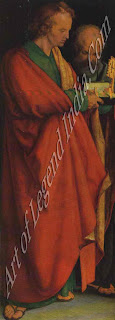 These
panels form Darer's last great masterpiece in painting memorably combining
Northern precision of detail with Italian amplitude of form. St John and St
Peter are shown on the left, St Paul and St Mark on the right. The panels may
have originally been conceived as wings of a triptych, but Darer himself
presented them to the city of Nuremberg as a pair.
These
panels form Darer's last great masterpiece in painting memorably combining
Northern precision of detail with Italian amplitude of form. St John and St
Peter are shown on the left, St Paul and St Mark on the right. The panels may
have originally been conceived as wings of a triptych, but Darer himself
presented them to the city of Nuremberg as a pair.
Writer - Marshall Cavendish
 The
Tuchers were one of the leading families of Nuremberg. There was probably
originally companion portrait of Elsbeth's husband, showing him facing her, as
Durer painted another married couple from the family in this format.
The
Tuchers were one of the leading families of Nuremberg. There was probably
originally companion portrait of Elsbeth's husband, showing him facing her, as
Durer painted another married couple from the family in this format.  This marvellously naturalistic study is justifiably on' of Durer's most popular
works. It is point in watercolour and gouache. Durer was a born craftsman and
complete master of every technique to which he turned his hand.
This marvellously naturalistic study is justifiably on' of Durer's most popular
works. It is point in watercolour and gouache. Durer was a born craftsman and
complete master of every technique to which he turned his hand.  These
panels form Darer's last great masterpiece in painting memorably combining
Northern precision of detail with Italian amplitude of form. St John and St
Peter are shown on the left, St Paul and St Mark on the right. The panels may
have originally been conceived as wings of a triptych, but Darer himself
presented them to the city of Nuremberg as a pair.
These
panels form Darer's last great masterpiece in painting memorably combining
Northern precision of detail with Italian amplitude of form. St John and St
Peter are shown on the left, St Paul and St Mark on the right. The panels may
have originally been conceived as wings of a triptych, but Darer himself
presented them to the city of Nuremberg as a pair. 
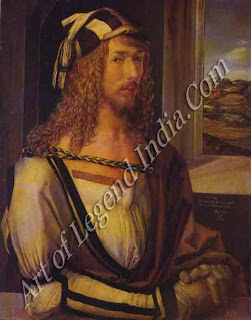
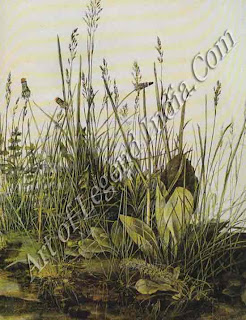
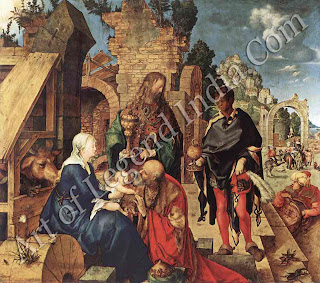
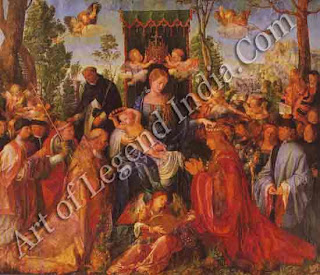
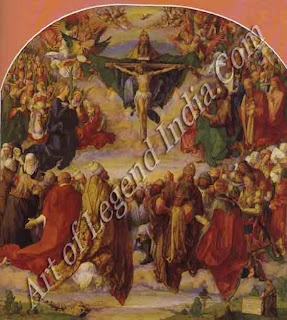










0 Response to "German Great Artist - Albrecht Durer Painting Gallery"
Post a Comment